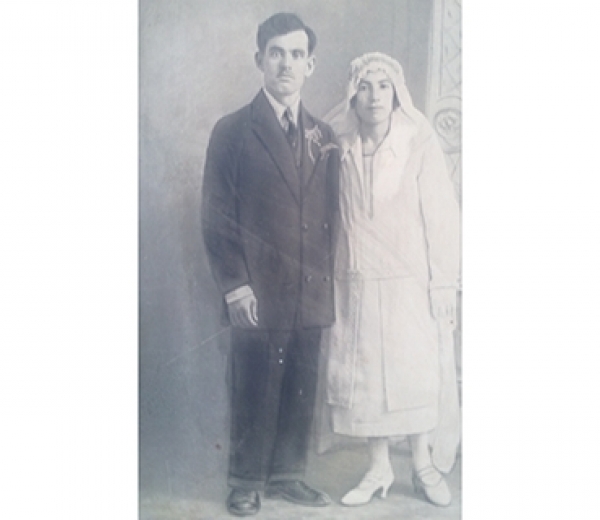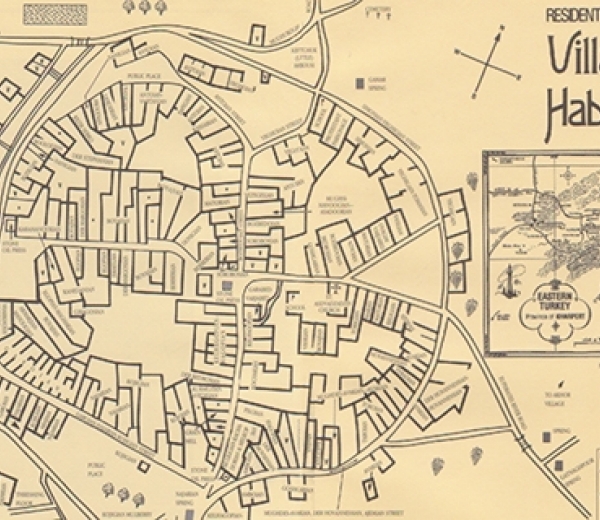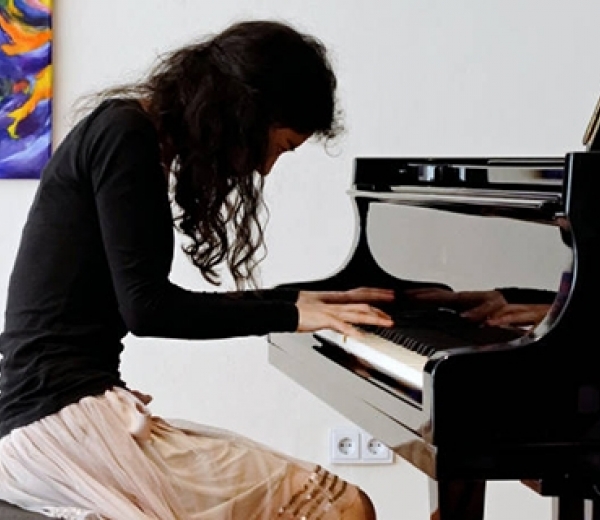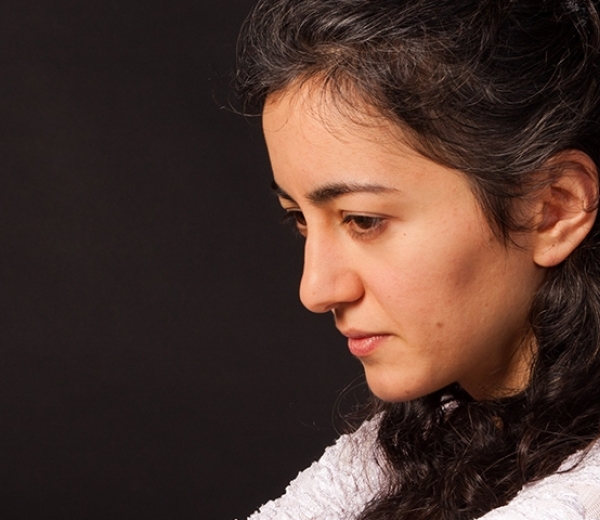Nare Karoyan
Submitted by global publisher on Tue, 06/21/2016 - 19:29
English
Intro:
Pianist Nare Karoyan grew up in Yerevan, surrounded by contemporary art and dozens of vinyl records. This special atmosphere, created by the merging of different means of expression, remains an inexhaustible source of energy for her. During her quest to hone her artistic skills, Nare has had the honor to work with unique personalities like Pascal Devoyon, Pierre-Laurent Aimard, Peter Eicher, Anthony Spiri and Gérard Buquet. But none of this would have been possible without Boghos Noubar Pasha – a wealthy Armenian who purchased her orphaned great-grandparents from the Turks and Kurds during the Armenian Genocide and gave them a new life. Below, Nare tells her family’s story in her own words.
Weight:
-8 700
Story elements:
Text:
Pianist Nare Karoyan grew up in Yerevan, surrounded by contemporary art and dozens of vinyl records. This special atmosphere, created by the merging of different means of expression, remains an inexhaustible source of energy for her. During her quest to hone her artistic skills, Nare has had the honor to work with unique personalities like Pascal Devoyon, Pierre-Laurent Aimard, Peter Eicher, Anthony Spiri and Gérard Buquet. But none of this would have been possible without Boghos Noubar Pasha – a wealthy Armenian who purchased her orphaned great-grandparents from the Turks and Kurds during the Armenian Genocide and gave them a new life. Below, Nare tells her family’s story in her own words.
Text:
Like a potter coats his jug, so has Boghos Noubar Pasha shaped my family. That’s the reason I’ve called my story “Noubarashen” (“constructed by Noubar”). I owe a debt of gratitude to this man.
The wall of the basement bedroom in my family home is adorned with a black and white photograph. It’s a wedding photo of my great-grandmother Altoun Antoyan and great-grandfather Nazaret Karoyan, taken in the French town of Valence around 1927. The newlyweds attentively look at the camera; they had recently lost large parts of their families. What sort of people were my ancestors? I don’t know. I never met them.
Image:

Text:
| Altoun and Nazaret Karoyan |
I do know that my family’s history begins in the Habousi village in the Kharpert vilayet. The Antoyans and the Karoyans were neighbors and two of the biggest clans in the village. The massacres severely decimated both families, but the fates of Altoun and Nazaret was different. Barely escaping death, these children were saved by the Kurds and Turks who hid them in their cellars.
Family legend has it that sometime later, a wealthy Armenian purchased the two children from the Turks and Kurds and handed them over to an orphanage. This man’s name was Boghos Noubar Pasha.
Altoun and Nazaret passed the next few years at various orphanages – first the American orphanage in Kharpert, and later the Armenian orphanages in Aleppo and Beirut. Years later, their yearning for a more peaceful and secure life forced them to make several decisions. Again, their fate was tied to Boghos Noubar, whose second homeland was France. The orphaned children boarded a ship sailing for Marseille. Was it the same ship in Henri Verneuil’s film “Mayrig”? The ship that took the Zakarian family to Marseille? It’s possible.
Image:

Text:
| A map of the village of Habousi |
The small French town of Valence was the birthplace of my grandfather Jirair and his brother Kevork. Were they destined to become Frenchmen? Possibly, but their parents desired a homeland where they wouldn’t be outsiders, where they could speak their native tongue and raise their children as proud representatives of an ancient culture.
Though Soviet Armenia wasn’t their homeland, they made the decision to go on a long journey with many of their neighbors from Habousi. Rumors spread on the ship that owning a bible was forbidden – given that Armenia was a socialist country – so the Karoyan family bible was thrown into the sea. It turned out that the family's documents were inside.
The family and their old neighbors settled in the Yerevan suburb of Noubarashen, a neighborhood constructed by Boghos Noubar for repatriate families. This was the beginning of their “newcomer” status. The “new immigrants” brought with them Anatolian customs – their cuisine, large family gatherings and elements of their melodious language that they still used in daily conversation. Soon after, World War II began and Nazaret was drafted into the army. He was later declared as “missing in action.”
Image:

Text:
| Nare Karoyan |
I frequently read or hear about the silence of survivors. They don’t speak about episodes from the past; it is the same in our family. Stories are only about the destinies of individual people. If others were to accidentally hear such conversations, it would seem that one is talking about humanity in general. But the actual protagonists have long since passed.
One of these individuals is Boghos Noubar. The fact that he first saved, and then gifted a new home and a new life to our family makes him a family saint and a guardian angel. He’s a person who inspires us with his deeds.
Years ago, I had a revelation: the more I physically distanced myself from my roots, the more my interest in them grew. The more I knew, the more I wanted to learn. But given that I lived far away (I was studying in Germany), I didn’t even know that my father had delved into the family history and founded the Boghos Noubar Contemporary Art Center in Noubarashen.
In one of his works, Peter Balakian compares memory to an old carpet on which the images of one portion are clear and another portion is hanging from threads. In a third portion are passages. This image clarified for me the importance of defending the threads and passages of our memory. It intensified my admiration for the will of our ancestors to live, and the selfless assistance of thousands whose deeds are often known to us – but not their names. At the same time, my gaze was directed toward the future, in thanks.
Gazing through memory
As a result, I called my concert program “Gazing Through Memory.” It’s the memory, like the photo of my ancestors’ wedding, gazing directly at me. My memory’s road is the path of my family’s history, from Anatolia to Syria and Lebanon, then to France and finally to Soviet Armenia.
A few years ago in Germany, I met the Turkish composer Zeynep Gedizlioğlu. In a short time, we became good friends. When I received an invitation to participate in the PEN-Exil event organized by the West German radio station, Zeynep composed a piece for me on the event’s theme of Turkey. The name of the piece was “Denge” (“Balance”) – the symbolic balance between the histories of our two peoples underscores the primary notes of the work. “Denge,” with its eastern resonance, captivated me.
I only found out last year that my relatives were also in Aleppo and Lebanon. This news gave me no peace until I found a piece of eastern music, for the piano, to direct my memory’s gaze toward the East. After weeks of searching, I contacted the Lebanese composer Karim Haddad who lives in France. He sent me a small work entitled “47 lat. Nord, 3 long. Ouest.” Despite the composition’s contemporary approach, there are sounds of percussion instruments, with improvised nuances of Arabic mughams (folk music). Haddad lives in France and the composition’s title is based on the geographic coordinates of a French island. For me, this was a symbolic link to the history of our family.
Finding a piece for the piano with Syrian roots was very difficult. My last hopeless attempt was to write to the Syrian composer Kareem Roustom, who was living in America. He responded quickly. He wrote that he had no piano compositions, but that he really wanted to contribute to my work and would definitely write something for me. In addition, Roustom wrote about his grandmother, who would leave food outside the gates of her house for the Armenian refugees during the years of the Armenian Genocide. I found all this to be very moving.
A few weeks later, I received a letter – the composition, “Oh people, leave me to my sorrows.” It was an improvisation based on a song by Sayed Darvish. Another link to my family: the Egyptian Darvish was a contemporary of Boghos Noubar.
I continued the musical mapping of my family’s story. France was represented in the Suite Française series, consisting of 16th century national dances. This creation, with its western quietude and lightness, holds a special place in the eastern melancholic and serious program.
And finally, Armenia. Is Armenian music possible without Komitas? Not likely. The compelling dances of Yerevan, the bold and masculine dances of Shushi, the melodic dances of Vagharshapat – ardent and compassionate, as arranged by Willy Sargsyan. I ended this musical road with the “Dedicated to Komitas” creation of Haroutyun Delalyan, which is proof that we keep the spirit of Komitas alive.
This is a musical reflection of that past world that still casts a shadow over us today. One hundred years after the Armenian Genocide, I too wished to walk along the road trodden by my family…with music.
The “Gazing through Memory” project is an expression of deep gratitude and is dedicated to the memory of Boghos Noubar Pasha.
Cover photo: Nare Karoyan (by Markous Hoffman)
The story is verified by the 100 LIVES Research Team.
Subtitle:
Armenian pianist maps her family’s history with music
Story number:
222
Header image:

